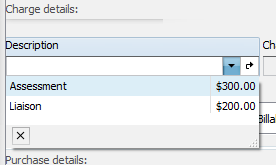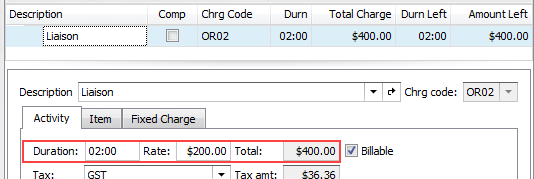Rate rises and charge code-based estimates
The estimate rate adjuster applies a little differently to estimates that are 'policed' via charge codes.
When the estimate contains charge codes the utility is not relevant or necessary. Adjustments happens automatically: when activity rates rise there is the same amount of money left in the estimate cost as before, so there is less time left for any updated activities, as seen in the first example below.
However, the estimate can contain activities even though it is policing via their charge codes. Here the estimate rate adjuster can update an estimate cost when the corresponding activity's rate rises.
Below very simple scenarios illustrate all this in practice.
The case category specifies that estimates police via charge codes and contain charge codes. It also specifies that only costs linked to the charge codes can be entered.
Estimate cost at case in this category
Charge codes do not have a rate. Here the estimate cost is a charge code (OR02), so you must enter a rate; we used $200/hr. Two hours of this makes the total estimate cost $400.

It is important to understand that when an estimate polices via charge codes, the Duration left is a kind of 'stand-in' value. It is calculated by dividing the amount of money left by the rate of the estimate cost. As we see below, the duration left for the different possible activities will differ, depending on their own rates.
Activities
- Two activities in the Activity list are linked to this category and have the same OR02 charge code.
- They have difference rates.

Adding a cost at a case with this estimate
Naturally the only two activities that can be added to the case are the two we have already seen:

When we choose Assessment we see that we can enter up to an hour and twenty minutes. This is $400 divided by 300 dollars per hour (400÷300).

No cost was added in this example.
Similarly, when we choose Liaison we see that we can enter up two hours (400÷200).

No cost was added in this example
Adding a cost at the case after the activity rate rises
The rate for Liaison has been increased at the Activity List.

Naturally the estimate cost (see above) is unchanged.
Now when we choose Liaison we see that we can only enter up one hour and 36 mins (400÷250). This is because its activity rate is higher but the estimate cost total is the same.

The case category specifies that the estimates police via charge codes and contain activities. It also specifies that only costs linked to the charge codes (in those activities) can be entered.
The possible activities start as in the previous example:

Once again, the rate for the estimate cost is $200/hr however this comes from the rate of the Liaison activity at the time of creating the estimate. Here the total cost is the same as the first example, i.e. $400.

As before, when an estimate polices via charge codes, the Duration left is a 'stand-in' value. It is calculated by dividing the amount of money left by the estimate cost rate. As we've seen, the duration left for the different possible activities that can be added (via the activity's charge code) will differ, depending on their own rates. This is less obvious when the estimate contains activities, but it remains true.
Adding a cost at the case
This is the same as in the scenario above, pre-rate rise. Activities with different rates have different maximum durations.
Adding a cost at the case after the Liaison rate rises
The rate for Liaison has been increased at the Activity List.

The situation is the same as above if the adjuster is not run. Estimate costs stay the same. The activity rate is higher so there is less duration left for activities whose rates have risen.
Note that this is true even when the estimate cost was created from an activity whose rate has subsequently risen. Unlike when estimates police via activities, when you add a cost from the estimate and it is the same activity as the estimate cost, the rate applied is not the rate in the estimate, it's the updated rate at the Activity List. This is because its the charge code of this estimate cost and its total cost that matters.
However, here you can run the adjuster to increase estimate costs because your estimates contain activities whose rates have been increased in the Activity List and these can be correlated with estimate costs. This is demonstrated below.
Adding a cost at the case after the Liaison rate rises and the rate adjuster has run
As described in detail at Estimate Rate Adjuster duration adjustment options there are three durations options.
Let's see the effects on two identical estimate costs, one partly spent and one unspent:

The rate for Liaison is increased at the Activity List.

The rate rise adjuster is run. Below we see the results after running with each of the duration options.

Below you can see that the first two options increased the total estimate cost, with the second option increasing it less if costs have already been charged against the estimate. The third option kept the same total estimate cost and amount left.
Remember that the Duration left is a 'stand-in' value. What's important are the Total Charge and the Amount Left.
Option A

Option B

Option C

